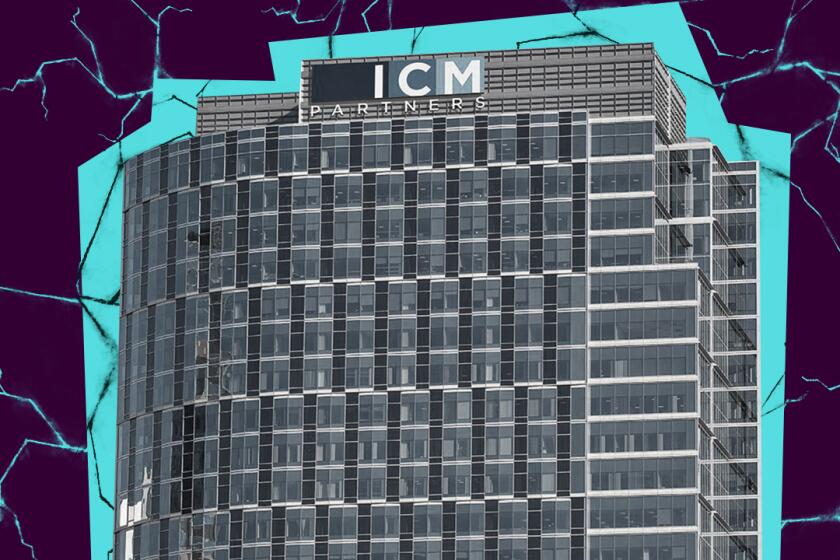CAA buys rival ICM talent agency in landmark deal valued at $750 million

- Share via
Century City-based Creative Artists Agency has completed its acquisition of neighboring ICM Partners in a landmark deal that is likely to transform Hollywood’s talent agency business.
The two companies announced the deal in a statement Tuesday and said they would have 3,200 employees across 25 countries.
The takeover was first announced in September but took longer than expected to clear a regulatory review by the Department of Justice and the Federal Trade Commission as the industry experiences a wave of deal-making.
Although financial terms were not disclosed, the acquisition was valued at $750 million, putting a combined value for the two businesses, including debt, of $5 billion, according to a person with knowledge of the deal who was not authorized to comment.
The deal reduces the number of top agencies to three dominant players: CAA, WME and United Talent Agency. ICM is the fourth largest firm. The combination of the two companies will give the emerging entity the heft to better compete against Beverly Hills-based Endeavor (the parent of WME), which has been on a growth spree and last year held an initial public offering.
“Today marks a new chapter in the history of our company, positioning us better than ever to deliver extraordinary opportunities for many of the world’s preeminent artists, athletes, thought leaders, brands, and organizations in entertainment, sports, and culture,” CAA Co-Chairmen Kevin Huvane, Bryan Lourd and Richard Lovett said in a joint statement.
For the record:
9:58 a.m. July 5, 2022A previous version of this story said 105 of 425 ICM employees wouldn’t be joining CAA. There are 105 ICM employees being laid off; 425 will join CAA.
The pairing, however, will mean significant jobs losses at ICM: 425 ICM employees will join CAA as part of the deal, but 105 are being cut, said the person familiar with the sale.
CAA’s acquisition of its smaller rival is part of a wider consolidation that is reshaping Hollywood as media companies boost their film and TV offerings for streaming platforms. It comes at a time of rapid changes in the talent representation industry, where power has shifted away from A-list actors and directors toward creators of content such as writers and producers.
“There is this belief that synergy is power and that when you control the talent, you can make things happen,” said Stephen Galloway, dean of Chapman University’s Dodge College of Film and Media Arts. “There has been through the past couple of decades a trend towards consolidation across the industry, which, frankly, is very troubling. None of this is great for individual clients and talent.”
CAA will now have access to ICM’s lucrative publishing business and its top clients, including “Grey’s Anatomy” creator Shonda Rhimes, actor Samuel L. Jackson, director Spike Lee and Ellen DeGeneres. ICM also represents “Breaking Bad” creator Vince Gilligan and “The Handmaid’s Tale” creator Bruce Miller.
After an L.A. Times investigation raised allegations of inappropriate behavior, the prominent agent has left ICM to reportedly start his own business.
CAA already represents such prominent talent as showrunner Ryan Murphy, actors Reese Witherspoon and Tom Hanks, and musical artists such as Ariana Grande.
“Combining with the best-in-class agency to build an even greater representation company for our clients and our colleagues is the core strategic reason for this move,” ICM’s Chris Silbermann and Ted Chervin said in a joint statement. “We couldn’t be more enthusiastic about our future together, and are energized by the sophisticated, forward-thinking representation we offer clients.”
CAA previously announced that it had bought full ownership of CAA-GBG Global Brand Management Group, a brand management agency. Earlier this month, Beverly Hills-based United Talent Agency said it had expanded its international footprint by acquiring one of the U.K.‘s biggest literary and talent companies, Curtis Brown Group.
Current and former employees of ICM Partners allege that the talent agency tolerated harassment and misconduct toward women and people of color.
But CAA, ICM and other agencies have weathered a tough period over the last two years.
During the COVID-19 pandemic, several agencies laid off workers after productions shut down and live events were canceled.
Agencies also were squeezed by the effects of a losing battle with the Writers Guild of America that forced them to rein in the use of packaging fees and affiliated productions that had helped them diversify their business.













